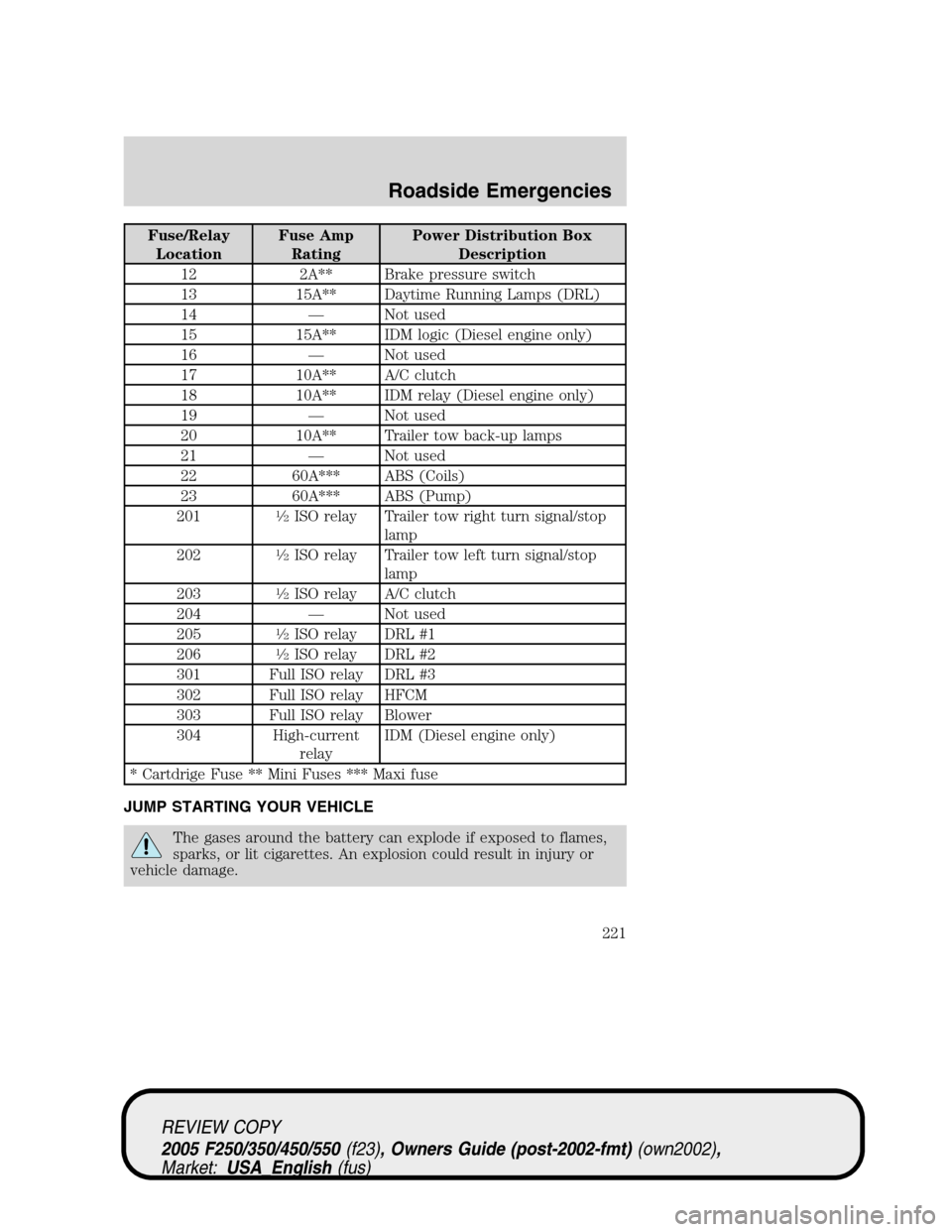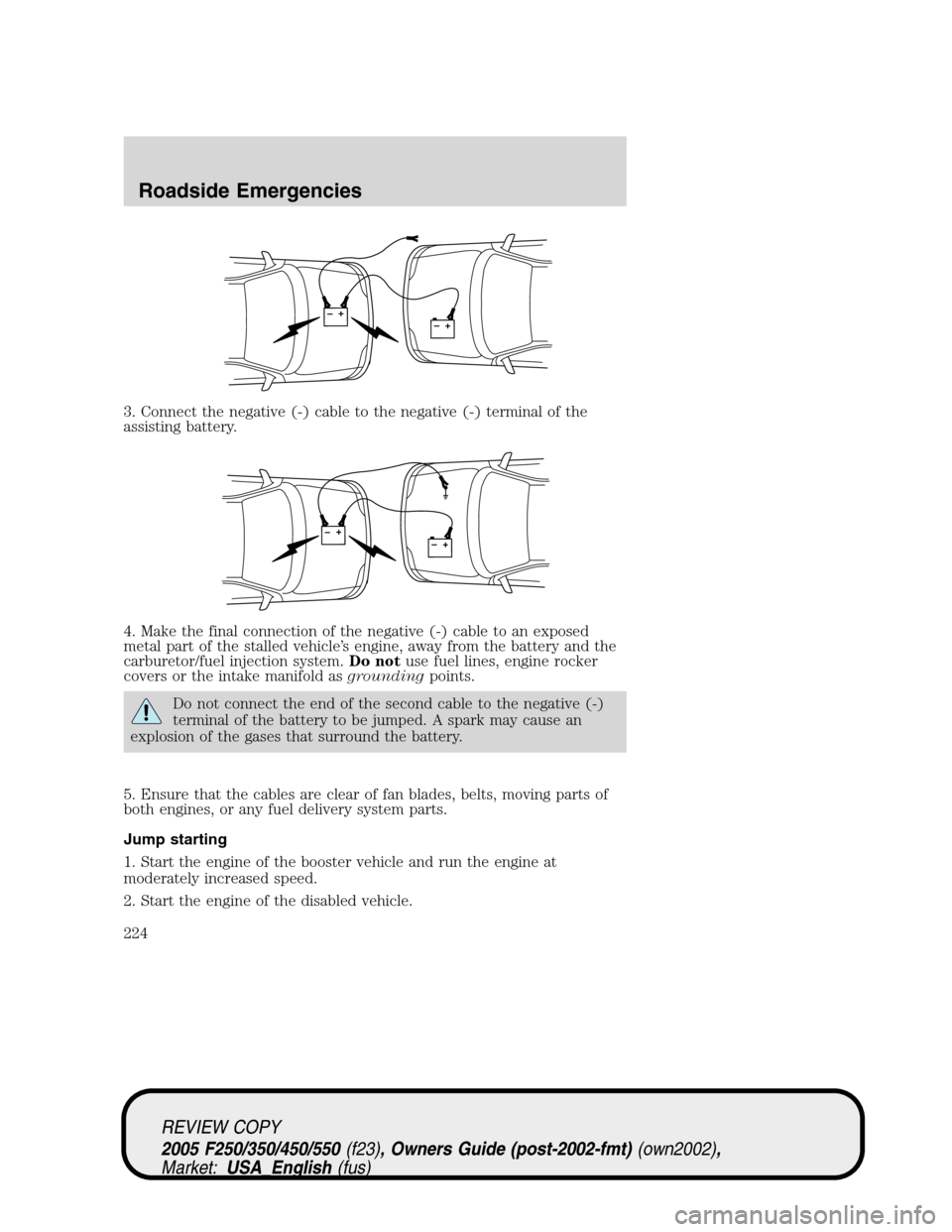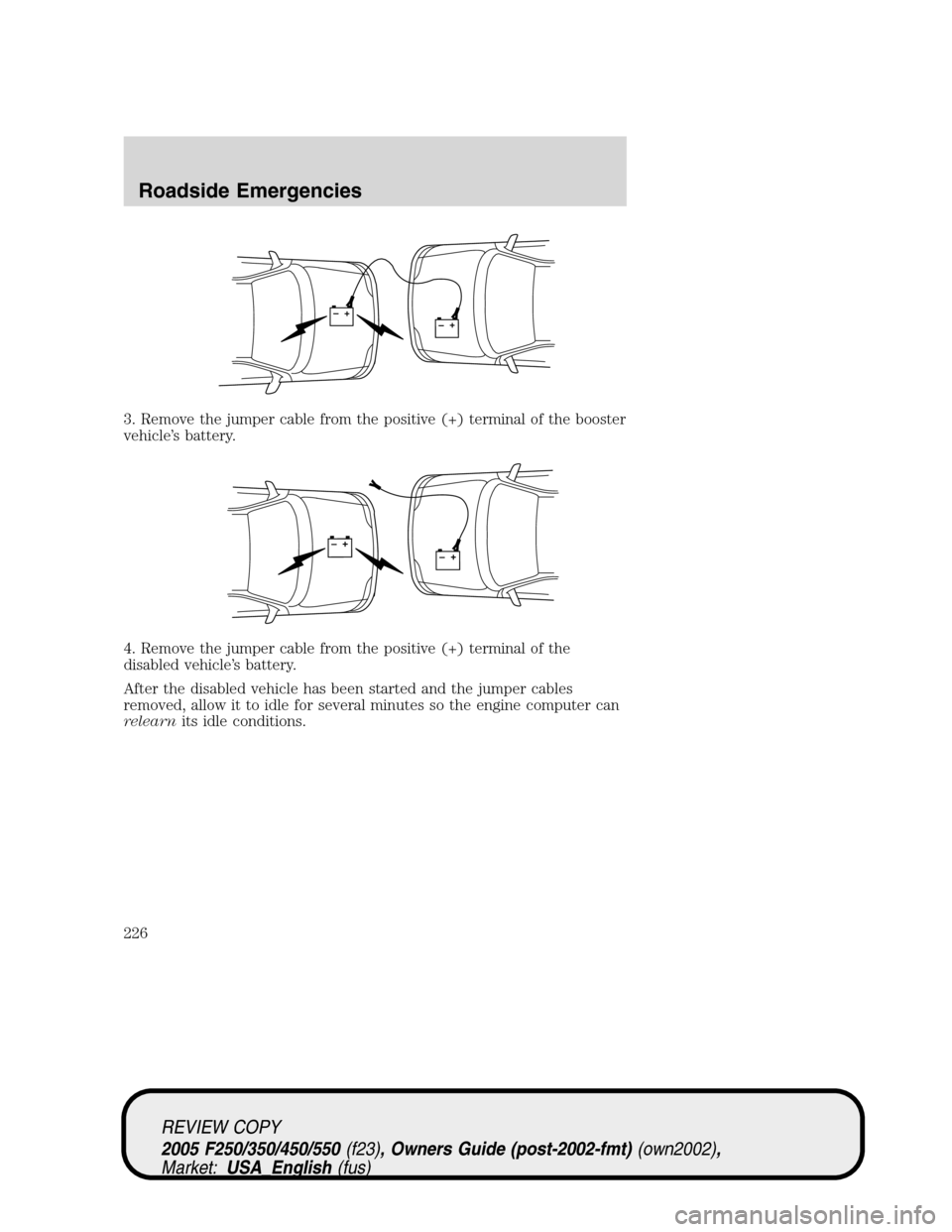2005 FORD SUPER DUTY jump start
[x] Cancel search: jump startPage 2 of 304

Locks and Security 80
Keys 80
Locks 80
Seating and Safety Restraints 90
Seating 90
Safety restraints 97
Air bags 108
Child restraints 117
Tires, Wheels and Loading 129
Tire Information 132
Tire Inflation 133
Changing tires 137
Lug Nut Torque 148
Vehicle loading 160
Trailer towing 165
Recreational towing 174
Driving 175
Starting 175
Brakes 181
Transmission operation 184
Roadside Emergencies 211
Getting roadside assistance 211
Hazard flasher switch 212
Fuel pump shut-off switch 213
Fuses and relays 213
Jump starting 221
Wrecker towing 227
Customer Assistance 229
Reporting safety defects (U.S. only) 237
Table of Contents
2
REVIEW COPY
2005 F250/350/450/550(f23), Owners Guide (post-2002-fmt)(own2002),
Market:USA_English(fus)
Page 211 of 304

GETTING ROADSIDE ASSISTANCE
To fully assist you should you have a vehicle concern, Ford Motor
Company offers a complimentary roadside assistance program. This
program is separate from the New Vehicle Limited Warranty. The service
is available:
•24–hours, seven days a week
•for the New Vehicle Limited Warranty period of three years or
36,000 miles (60,000 km), whichever occurs first on Ford and Mercury
vehicles, and four years or 50,000 miles (80,000 km) on Lincoln
vehicles.
Roadside assistance will cover:
•a flat tire change with a good spare (except Ford GT which has a tire
inflation kit)
•battery jump start
•lock-out assistance (key replacement cost is the customer’s
responsibility)
•fuel delivery (2.0 gallons [7.5L], maximum two occurrences within 12
month period)
•towing of your disabled vehicle to the nearest Ford Motor Company
dealership, or your selling dealer if within 35 miles (56.3 km) of the
nearest Ford Motor Company dealership (one tow per disablement).
Even non-warranty related tows, like accidents, are covered (some
exclusions apply, such as impound towing or repossession).
Canadian customers refer to your Owner Information Guide for
information on:
•coverage period
•exact fuel amounts
•towing of your disabled vehicle
•emergency travel expense reimbursement
•travel planning benefits
USING ROADSIDE ASSISTANCE
Complete the roadside assistance identification card and place it in your
wallet for quick reference. In the United States, this card is found in the
Owner Guide portfolio in the glove compartment. In Canada, the card is
found in theOwner Information Guidein the glove compartment.
U.S. Ford or Mercury vehicle customers who require roadside assistance,
call 1–800–241–3673; Lincoln vehicle customers call 1–800–521–4140.
REVIEW COPY
2005 F250/350/450/550(f23), Owners Guide (post-2002-fmt)(own2002),
Market:USA_English(fus)
Roadside Emergencies
Roadside Emergencies
211
Page 221 of 304

Fuse/Relay
LocationFuse Amp
RatingPower Distribution Box
Description
12 2A** Brake pressure switch
13 15A** Daytime Running Lamps (DRL)
14 — Not used
15 15A** IDM logic (Diesel engine only)
16 — Not used
17 10A** A/C clutch
18 10A** IDM relay (Diesel engine only)
19 — Not used
20 10A** Trailer tow back-up lamps
21 — Not used
22 60A*** ABS (Coils)
23 60A*** ABS (Pump)
201
1�2ISO relay Trailer tow right turn signal/stop
lamp
202
1�2ISO relay Trailer tow left turn signal/stop
lamp
203
1�2ISO relay A/C clutch
204 — Not used
205
1�2ISO relay DRL #1
206
1�2ISO relay DRL #2
301 Full ISO relay DRL #3
302 Full ISO relay HFCM
303 Full ISO relay Blower
304 High-current
relayIDM (Diesel engine only)
* Cartdrige Fuse ** Mini Fuses *** Maxi fuse
JUMP STARTING YOUR VEHICLE
The gases around the battery can explode if exposed to flames,
sparks, or lit cigarettes. An explosion could result in injury or
vehicle damage.
REVIEW COPY
2005 F250/350/450/550(f23), Owners Guide (post-2002-fmt)(own2002),
Market:USA_English(fus)
Roadside Emergencies
221
Page 224 of 304

3. Connect the negative (-) cable to the negative (-) terminal of the
assisting battery.
4. Make the final connection of the negative (-) cable to an exposed
metal part of the stalled vehicle’s engine, away from the battery and the
carburetor/fuel injection system.Do notuse fuel lines, engine rocker
covers or the intake manifold asgroundingpoints.
Do not connect the end of the second cable to the negative (-)
terminal of the battery to be jumped. A spark may cause an
explosion of the gases that surround the battery.
5. Ensure that the cables are clear of fan blades, belts, moving parts of
both engines, or any fuel delivery system parts.
Jump starting
1. Start the engine of the booster vehicle and run the engine at
moderately increased speed.
2. Start the engine of the disabled vehicle.
+–+–
+–+–
REVIEW COPY
2005 F250/350/450/550(f23), Owners Guide (post-2002-fmt)(own2002),
Market:USA_English(fus)
Roadside Emergencies
224
Page 225 of 304

3. Once the disabled vehicle has been started, run both engines for an
additional three minutes before disconnecting the jumper cables.
Removing the jumper cables
Remove the jumper cables in the reverse order that they were
connected.
1. Remove the jumper cable from thegroundmetal surface.
Note:In the illustrations,lightning boltsare used to designate the
assisting (boosting) battery.
2. Remove the jumper cable on the negative (-) connection of the
booster vehicle’s battery.
+–+–
+–+–
REVIEW COPY
2005 F250/350/450/550(f23), Owners Guide (post-2002-fmt)(own2002),
Market:USA_English(fus)
Roadside Emergencies
225
Page 226 of 304

3. Remove the jumper cable from the positive (+) terminal of the booster
vehicle’s battery.
4. Remove the jumper cable from the positive (+) terminal of the
disabled vehicle’s battery.
After the disabled vehicle has been started and the jumper cables
removed, allow it to idle for several minutes so the engine computer can
relearnits idle conditions.
+–+–
+–+–
REVIEW COPY
2005 F250/350/450/550(f23), Owners Guide (post-2002-fmt)(own2002),
Market:USA_English(fus)
Roadside Emergencies
226
Page 300 of 304

waxing .....................................238
wheels ......................................239
wiper blades ............................241
Climate control (see Air
conditioning or Heating) ............37
Clutch
fluid ..........................................272
operation while driving ..........188
recommended shift speeds ....189
Compass, electronic
set zone adjustment .................71
Console ........................................67
overhead ....................................57
Controls
steering column ........................66
Coolant
checking and adding ..............255
refill capacities ................259, 281
specifications ..................283, 287
Cruise control (see
Speed control) ............................63
Customer Assistance ................211
Ford accessories for your
vehicle .....................................244
Ford Extended Service
Plan ..........................................235
Getting assistance outside
the U.S. and Canada ..............236
Getting roadside assistance ...211
Getting the service
you need .................................229
Ordering additional
owner’s literature ...................236
The Dispute Settlement
Board .......................................232
Utilizing the Mediation/
Arbitration Program ...............234D
Daytime running lamps
(see Lamps) ................................41
Dipstick
automatic transmission fluid .273
engine oil .................................249
Doors
lubricant specifications ..........283
Driveline universal joint
and slip yoke .............................277
Driving under special
conditions ..................188, 201, 204
sand .........................................203
snow and ice ...........................205
through water .................203, 207
E
Electronic message center ...67, 69
Emergencies, roadside
jump-starting ..........................221
Emergency Flashers .................212
Emission control system ..........269
Engine ........................................287
cleaning ...................................239
coolant .....................................255
diesel ...........................................8
fail-safe coolant ......................260
idle speed control ...................253
lubrication
specifications ..................283, 287
refill capacities ........................281
service points ..................247–248
starting after a collision .........213
Engine block heater .................180
Engine oil ..................................249
checking and adding ..............249
dipstick ....................................249
REVIEW COPY
2005 F250/350/450/550(f23), Owners Guide (post-2002-fmt)(own2002),
Market:USA_English(fus)
Index
300
Page 301 of 304

filter, specifications ........252, 280
recommendations ...................252
refill capacities ........................281
specifications ..................283, 287
Exhaust fumes ..........................180
F
Fail safe cooling ........................260
Fluid capacities .........................281
Foglamps .....................................41
Four-Wheel Drive vehicles .......193
description ..............................197
driving off road .......................199
electronic shift ................193, 197
indicator light .........................194
lever operated shift ................195
manual locking hubs ..............193
preparing to drive your
vehicle .....................................184
Fuel ............................................261
calculating fuel economy .72, 265
cap ...........................................263
capacity ...................................281
choosing the right fuel ...........264
comparisons with EPA fuel
economy estimates .................268
detergent in fuel .....................265
filling your vehicle
with fuel ..................261, 263, 266
filter, specifications ........265, 280
fuel pump shut-off switch .....213
improving fuel economy ........265
octane rating ...................264, 287
quality ......................................264
running out of fuel .................265
safety information relating to
automotive fuels .....................261
Fuel pump shut-off switch .......213
Fuses ..................................213–214G
Gas cap (see Fuel cap) ............263
Gas mileage (see Fuel
economy) ...................................265
Gauges .........................................16
transmission fluid
temperature gauge ...................20
H
Hazard flashers .........................212
Head restraints ...........................90
Headlamps ...................................40
aiming ..................................42, 44
autolamp system .......................40
daytime running lights .............41
flash to pass ..............................42
high beam .................................41
replacing bulbs ...................48–51
turning on and off ....................40
Heating
heating and air conditioning
system ...........................34–35, 37
Hood ..........................................246
I
Ignition ...............................175, 287
Infant seats
(see Safety seats) .....................120
Inspection/maintenance
(I/M) testing ..............................270
Instrument panel
cleaning ...................................241
cluster ........................................12
lighting up panel and
interior .......................................42
J
Jump-starting your vehicle ......221
REVIEW COPY
2005 F250/350/450/550(f23), Owners Guide (post-2002-fmt)(own2002),
Market:USA_English(fus)
Index
301